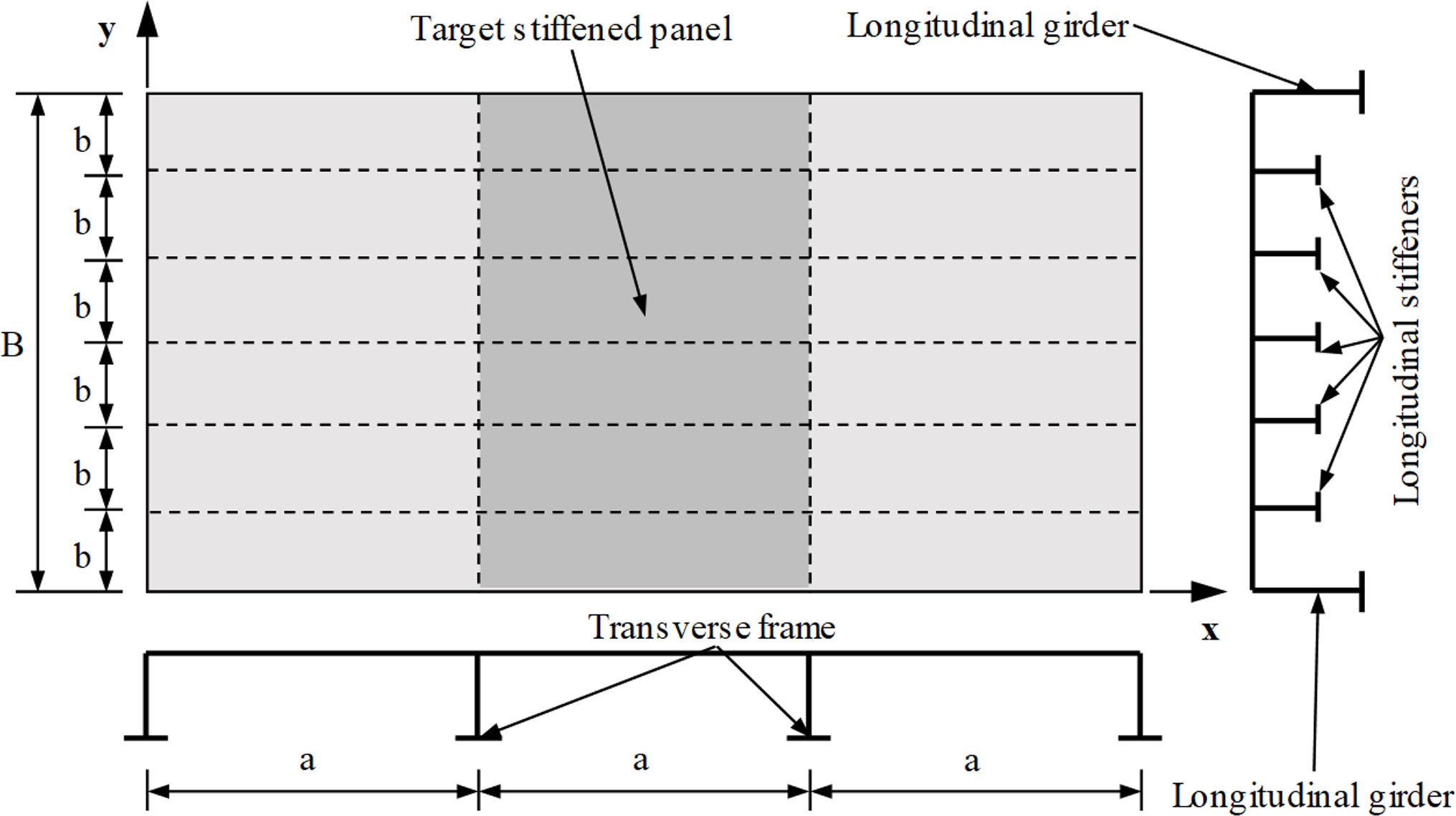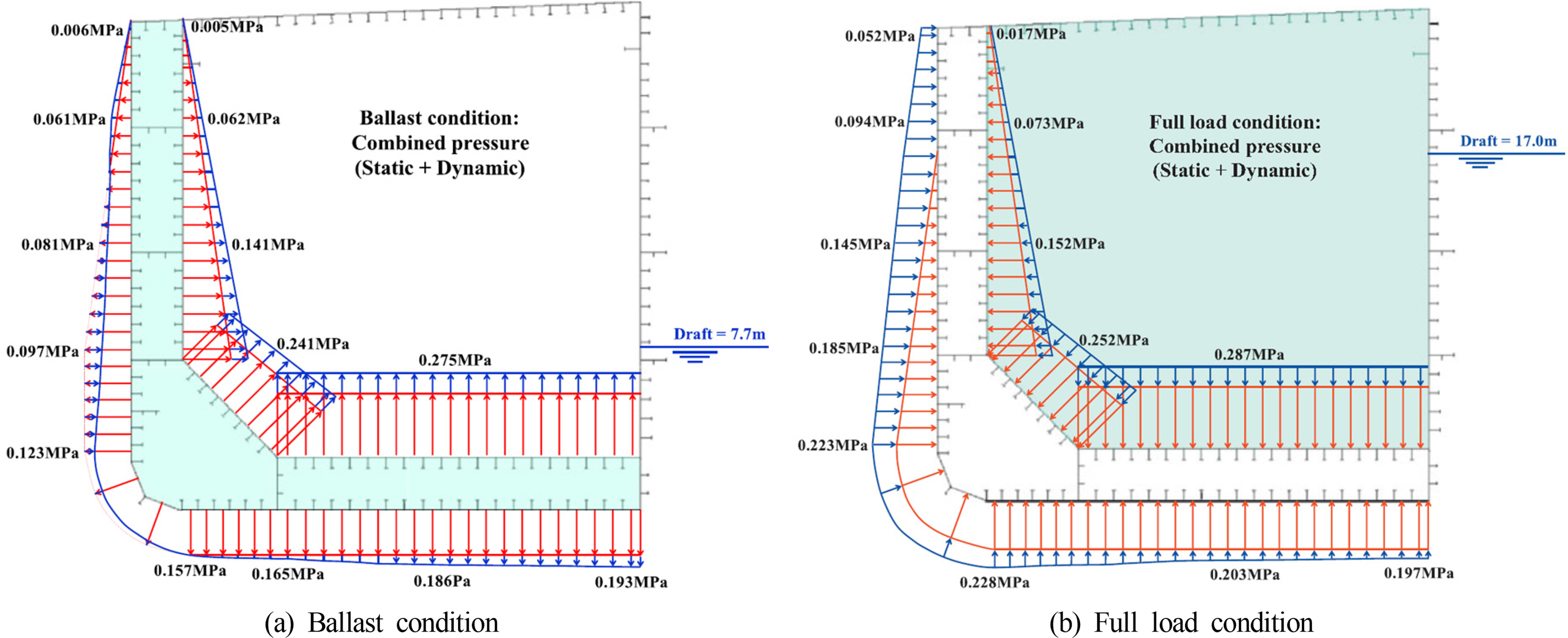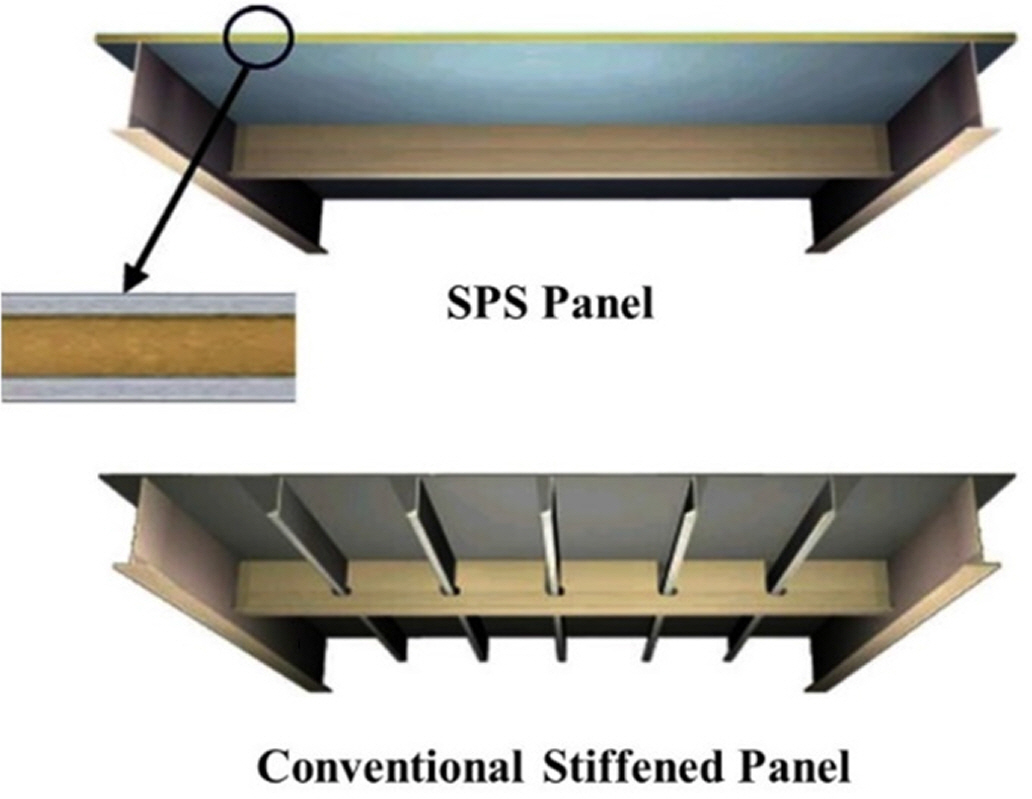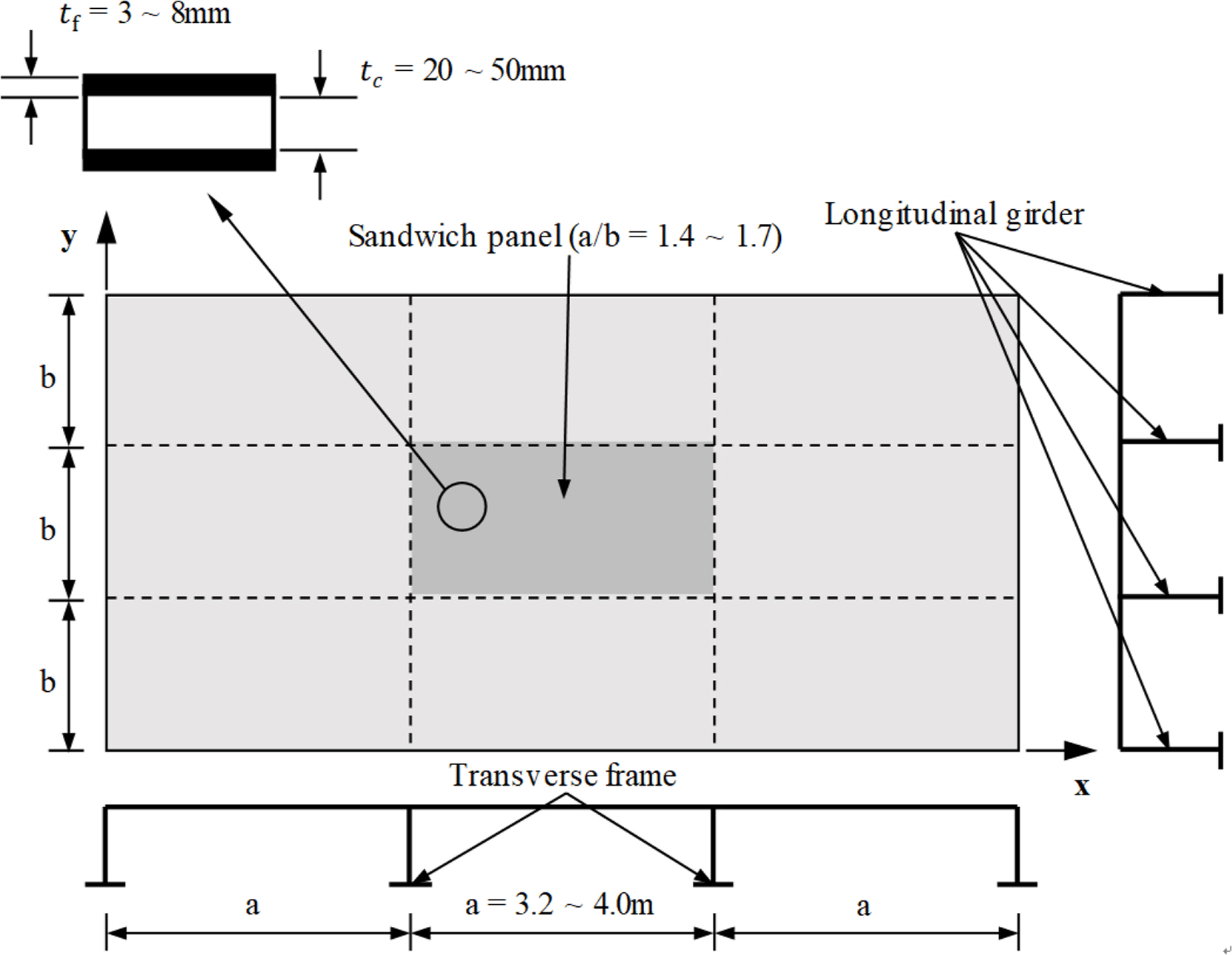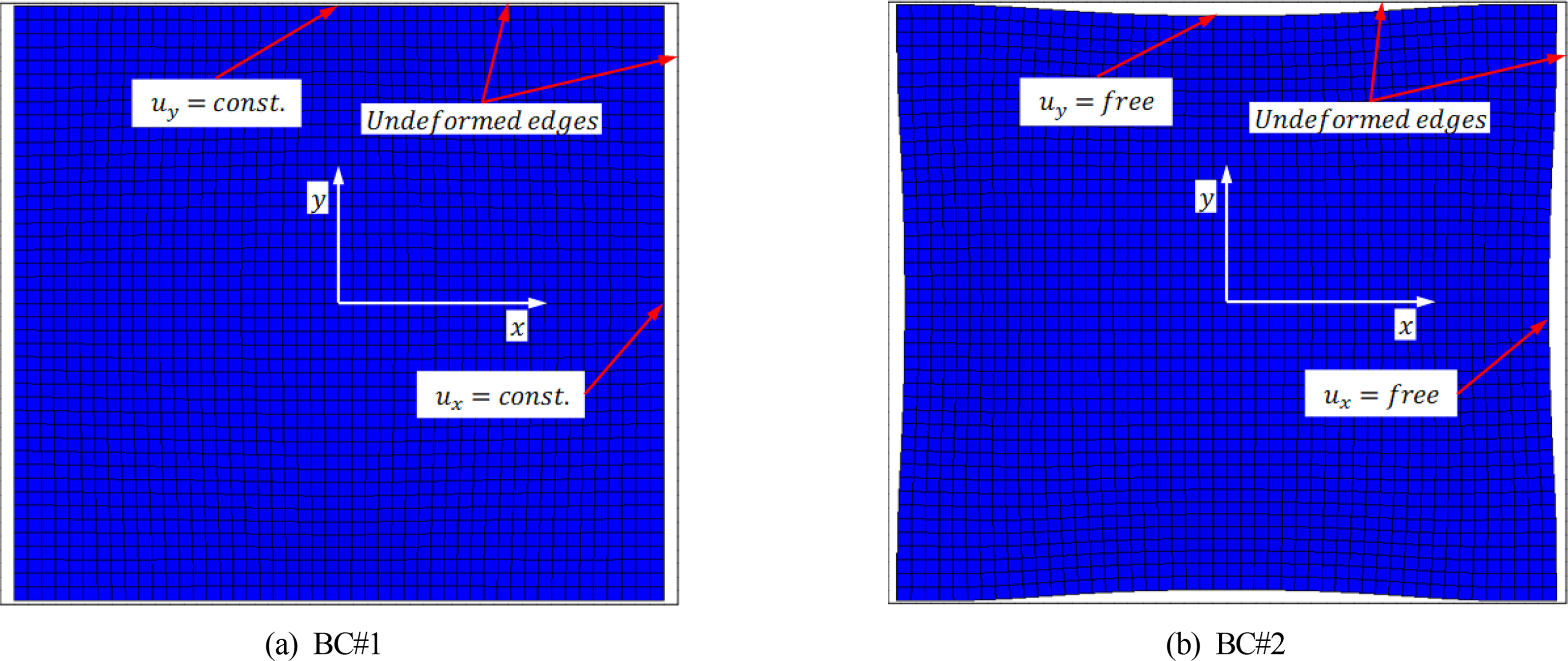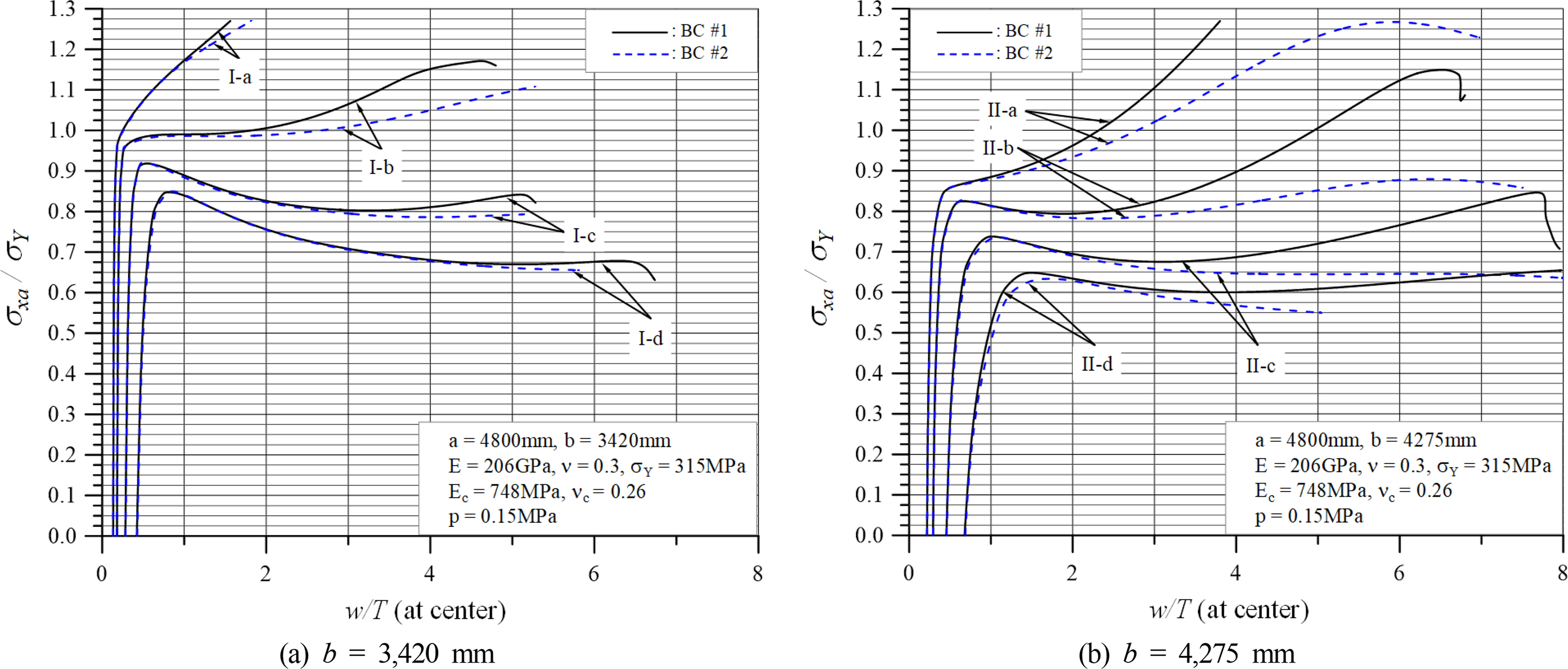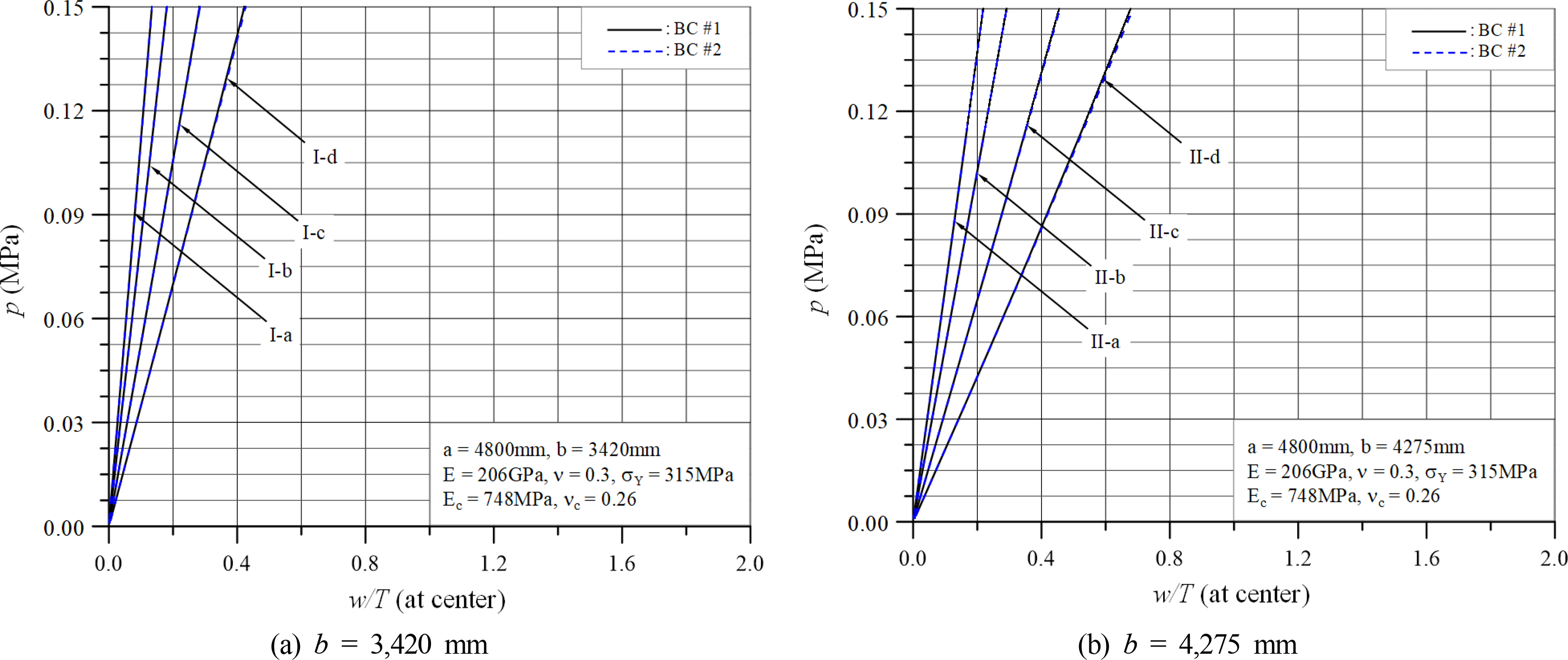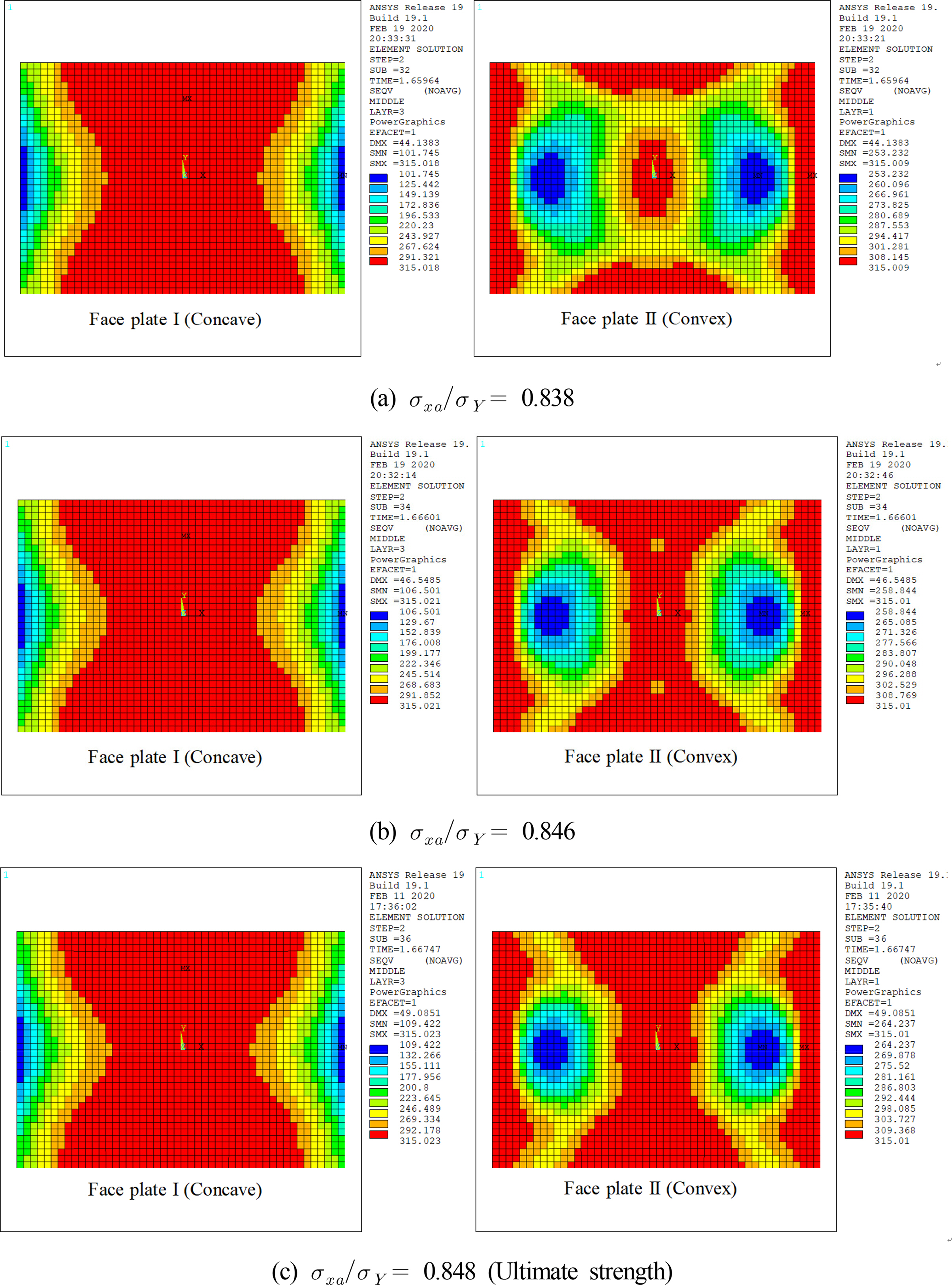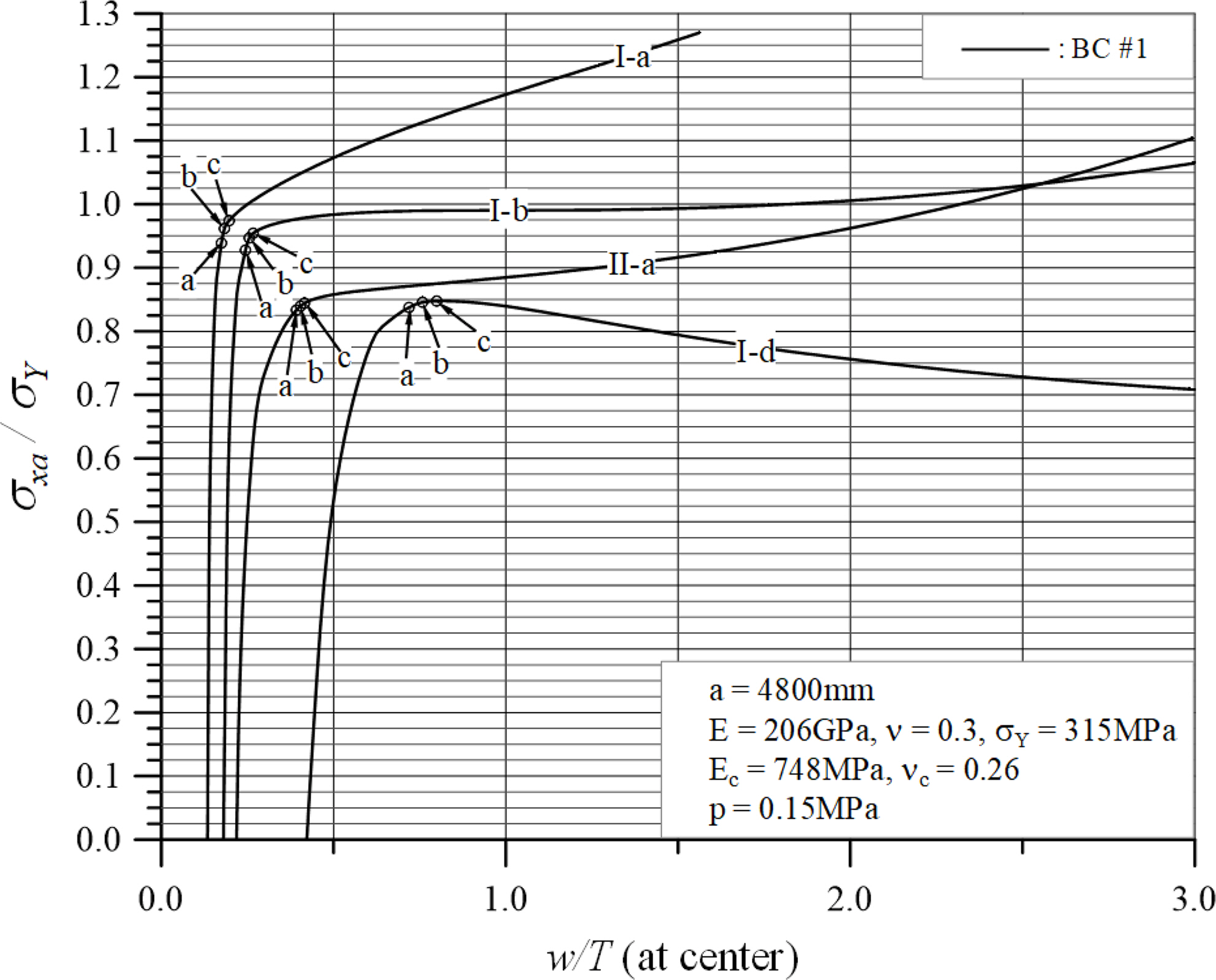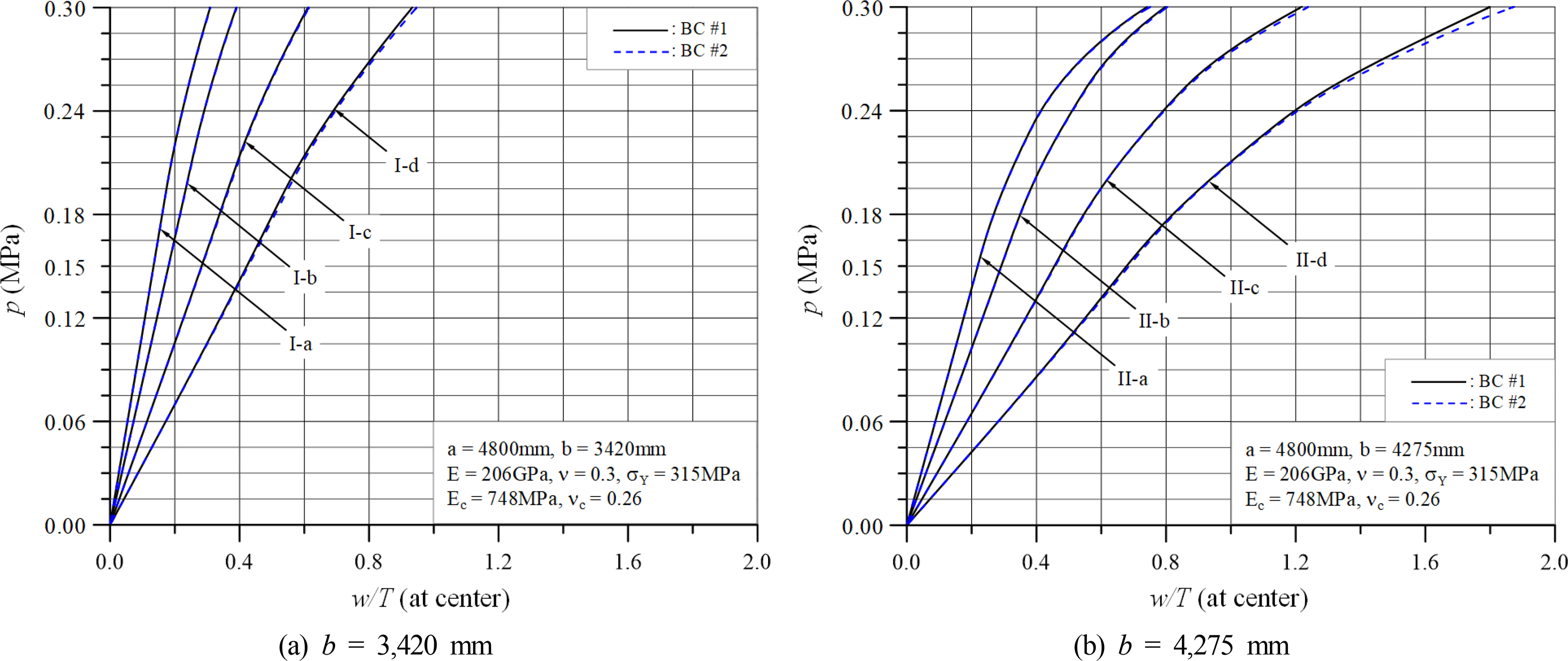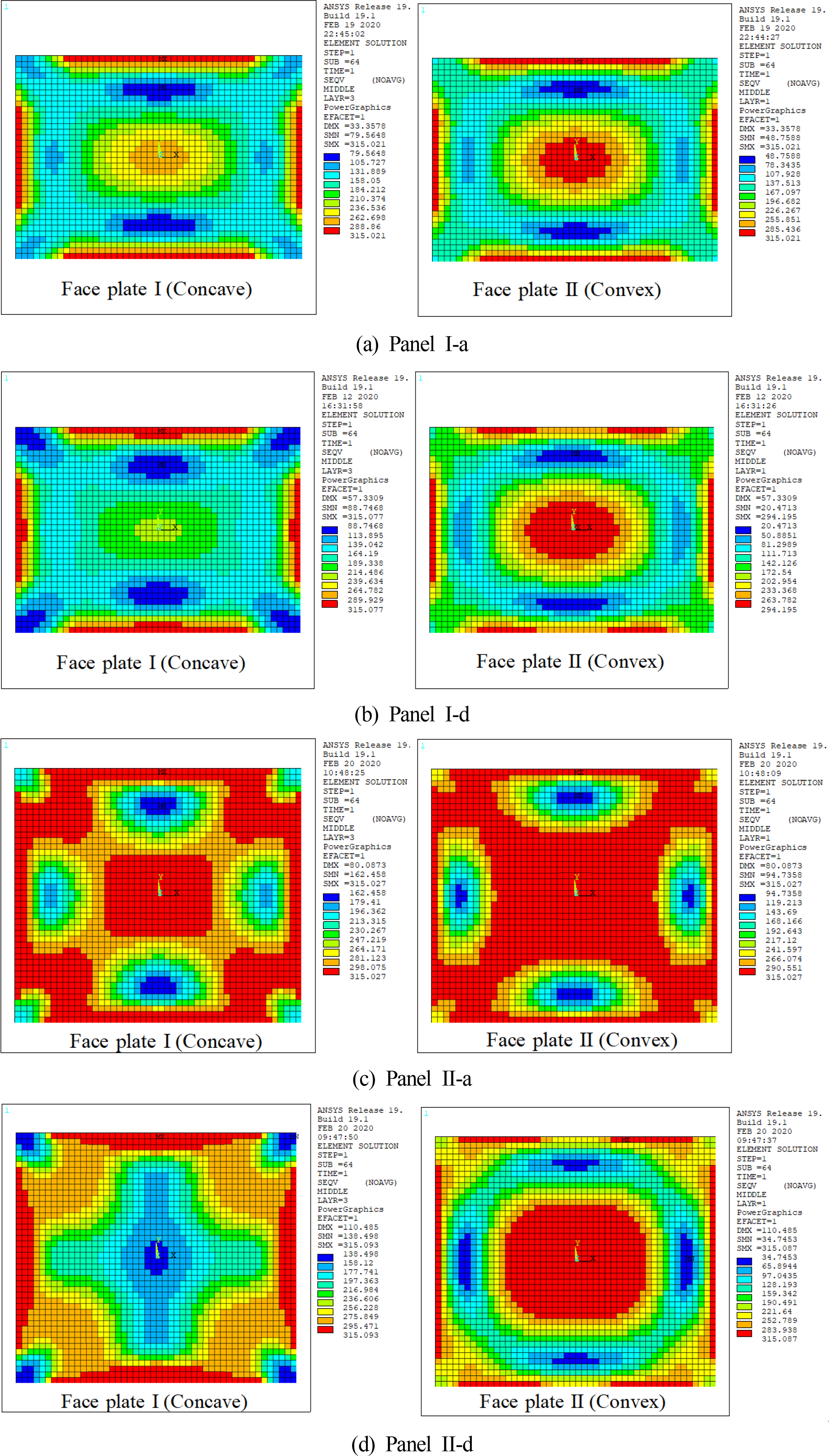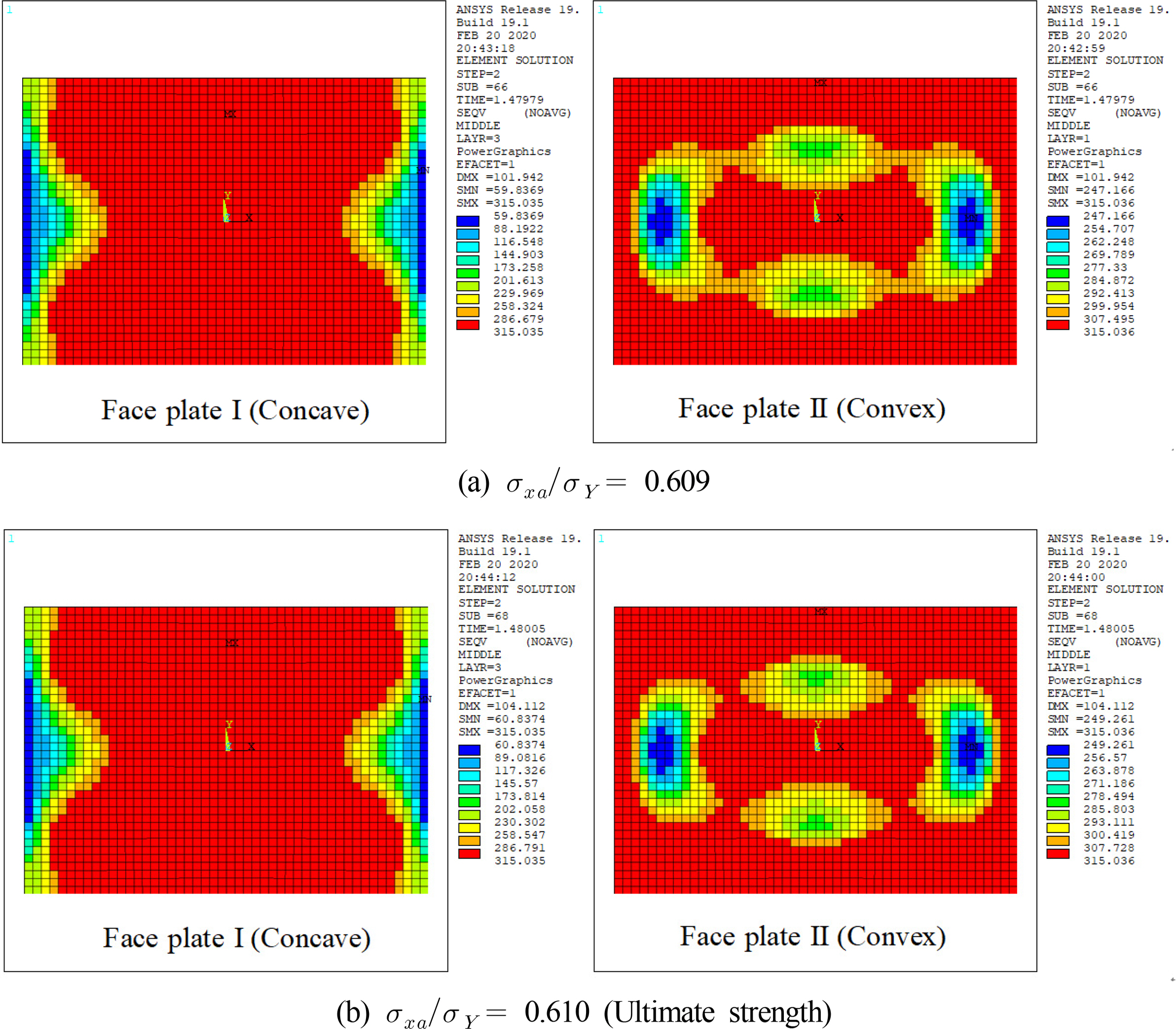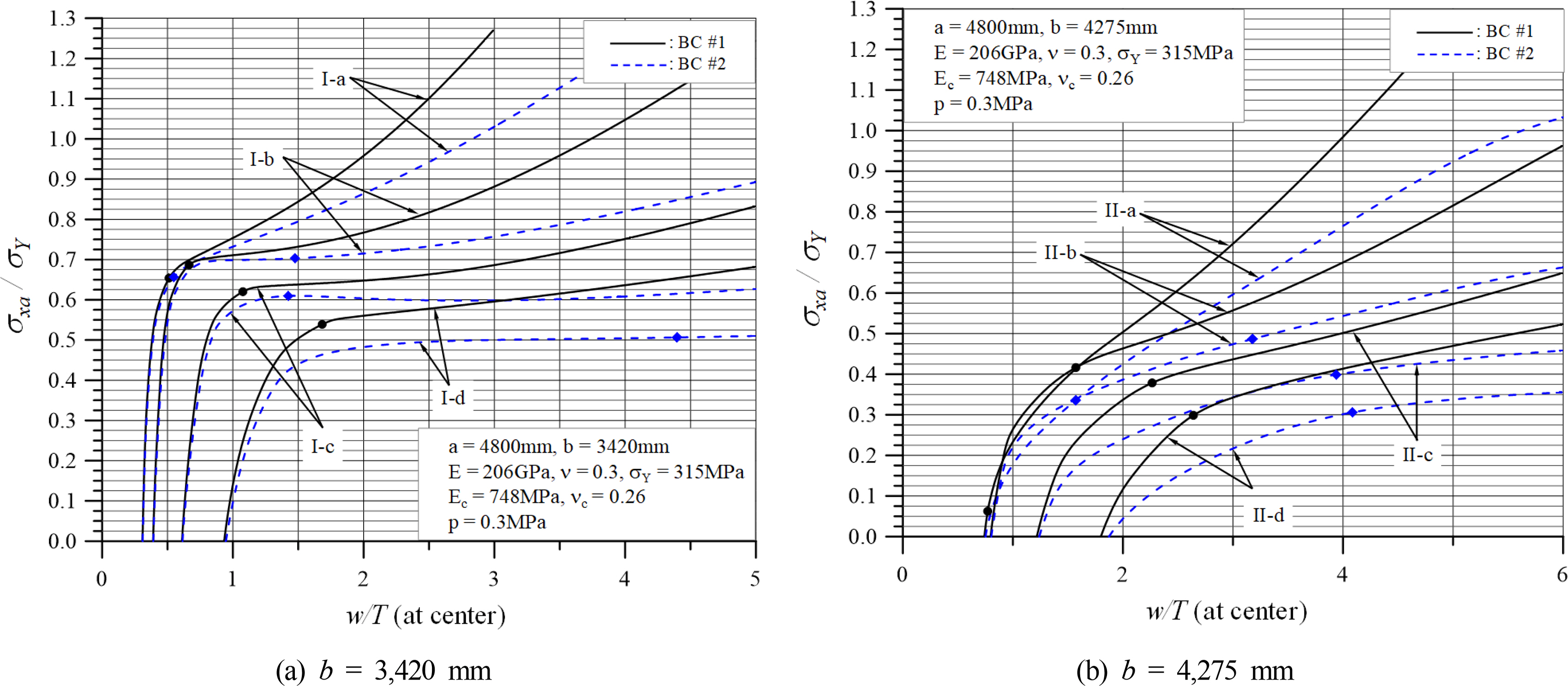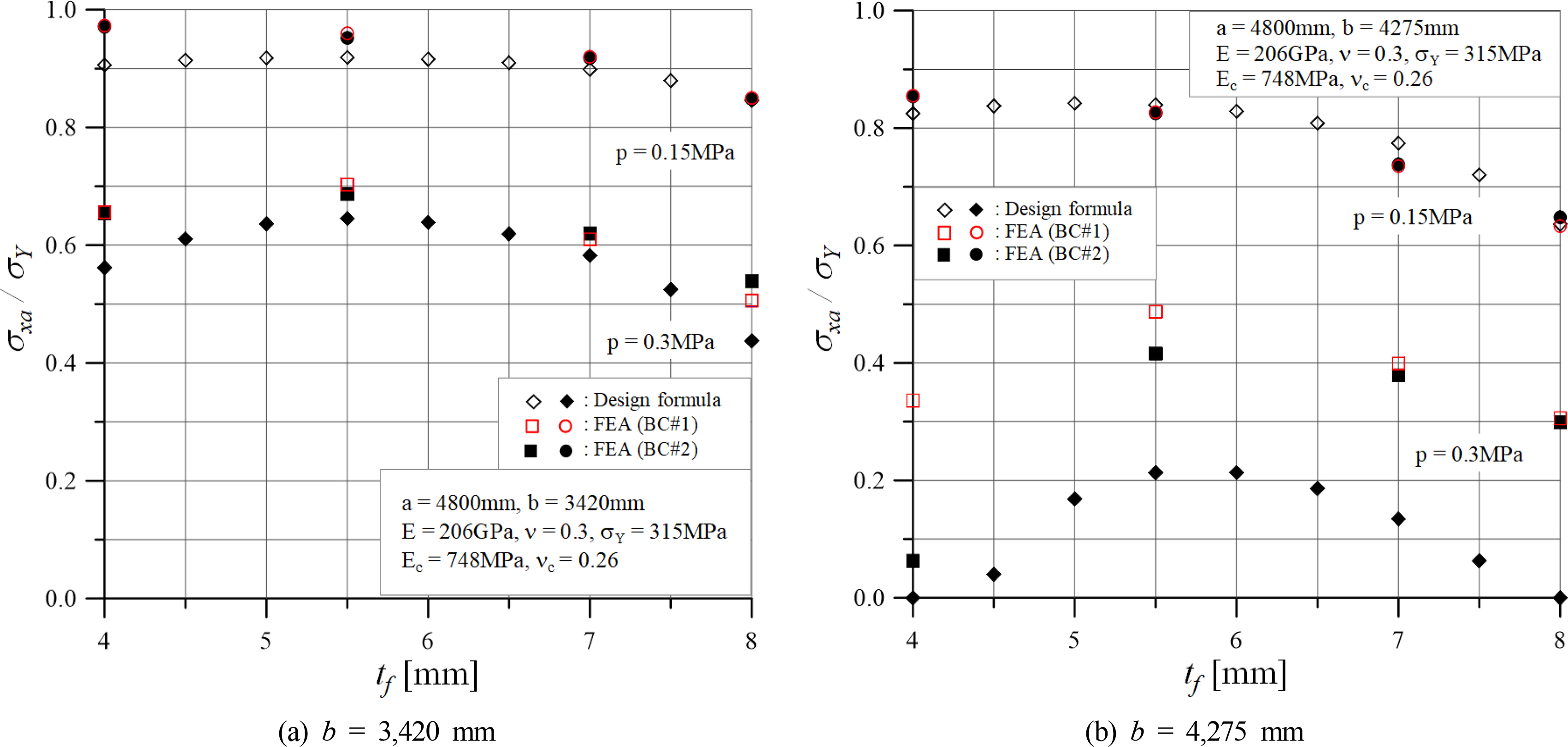3.1 Finite Element Modeling and Boundary Conditions
In
Fig. 5, the finite element modeling and boundary conditions used in this study are shown. Based on the experience obtained from previous studies and the mesh convergence study, a sandwich panel with a size of 4,800 × 4,275 mm (aspect ratio is approximately 1.1) was modeled using 48 × 44 four-node layered shell elements and a panel with a size of 4,800 × 3,420 mm (aspect ratio is approximately 1.4) was modeled using 48 × 36 four-node layered shell elements. The elements comprise of three layers, i.e., the face plate, core, and face plate having 100 mm or smaller sizes and square shapes. Both the face plate and core were modeled as isotropic materials. In addition, the core was modeled as a perfectly elastic material and the face plate as an elastic-perfectly plastic material. The material constants of the face plate and core are outlined in
Table 3.
The boundary conditions of the four edges of the panels were assumed to be clamped. The previous study used the boundary condition (BC#1) where the four edges of the panel boundary always maintain a straight line in the plane even if the panel is deflected as shown in
Fig. 6. In this study, however, we considered an additional boundary condition (BC#2) where a free in-plane displacement may occur. The support members around the panel were not included in the model. The details of these two boundary conditions are outlined in
Table 4.
For load application to the panel, lateral pressure was first applied before applying the in-plane compression load. In this study, to observe the ultimate strength behavior according to different lateral pressures, 0.15 MPa and 0.3 MPa were applied as uniform pressure vertically to the element plane of the finite element model, and the in-plane compression load was applied as uniform pressure to the edges of the element. The lateral pressure reached the operating load through load increments of 30 or more steps. Then, the ultimate strength was obtained by incrementing the in-plane compression load using the arc-length method. To prevent the rigid body motion, the displacements of the
x and
y directions were fixed to the four nodes at the center of the panel edges as shown in
Fig. 5. The elasto-plastic large deformation analysis was performed using the ANSYS software (
ANSYS, 1999).
3.2 Analysis of Ultimate Strength Behavior Characteristics
In
Figs. 7–
8, the nonlinear FEA results for the selected sandwich panels are shown. The maximum deflection (
w) at the center of the panel is normalized with the total thickness of the sandwich panels (
T = 2
tf +
tc) and the in-plane compression load (
σxa) along the length (
x direction) is normalized with the yield strength (
σY) of the face plate. First, to examine the behavior characteristics at the lateral pressure of 0.15 MPa, we can observe a relatively clear threshold where the strength is degraded after the in-plane compression load increases and reaches the ultimate strength, as shown in
Fig. 7. However, as shown in the graph for panel I-a, when the thickness of the sandwich panel is large, the threshold is not clear and a deflection behavior obtains for loads exceeding the yield strength. This analysis result is similar to the behavior of a thick plate with a low slenderness ratio and small initial deflection amount and appears more conspicuously in narrow thick panels. Furthermore, the deflection behavior for the boundary condition where the four edges of the sandwich panel always maintain an in-plane straight line (BC#1) and the boundary condition where the in-plane displacements are free (BC#2) remain almost constant up to the threshold and then begin to vary beyond the threshold. The strength degradation of BC#2 is larger than that of BC#1. The greater the thickness and breadth of the sandwich panel, the greater the difference. In the case when lateral pressure is 0.3 MPa as shown in
Fig. 8, the threshold is often unclear, and the difference in deflection behavior between BC#1 and BC#2 is larger than the case when the lateral pressure is 0.15 MPa. The difference was large in a low in-plane compression load as well when the panel breadth was 4,275 mm.
The maximum deflection at the center of each sandwich panel under a lateral pressure of 0.15 MPa is shown in
Fig. 9. When a lateral pressure of 0.15 MPa was applied, the maximum deflection increased almost linearly with the increase in lateral load. In the case of panels I-a and II-a with the largest bending rigidity, the deflection in lateral pressure was smaller. As a result, strength degradation did not occur after the ultimate strength in
Fig. 7 and deflection behavior appeared for loads exceeding the yield strength. In the case of I-b, a deflection smaller than that of II-a occurred by lateral pressure, and it is presumed that strength degradation did not appear clearly for the same reason because the bending rigidity was 92% that of II-a.
To define the ultimate strength for panels I-a, II-a, and I-b, we examined the progressive yielding pattern of the face plate. According to a previous study, in sandwich panels that were subjected to lateral pressure and in-plane compression load, yielding occurred continuously along the y-axis from the center to the edges of the panel in the face plate (Concave; face plate I) where compression stress occurred along the length owing to lateral pressure. In addition, the ultimate strength was reached on the opposite face plate (Convex; face plate II) as well if yielding occurred continuously from the center to the edges of the panel along the direction of the y-axis (
Kim, 2019).
The progressive yielding pattern for panel I-d with clear strength degradation after the ultimate strength is shown in
Fig. 10. With the increasing in-plane compression load, yielding occurs continuously on the face plate I along the y-axis from the center to the edges. On the face plate II as well, the ultimate strength is reached as the yielding of the edges and center are combined right before the ultimate strength is reached. This progressive yielding pattern is consistent with the previous study. In
Fig. 7, the same strength degradation was observed in the panels after reaching the ultimate strength. The same progressive yielding patterns could be also found for panels I-a, II-a, and I-b. The yielding pattern for panel I-a is shown in
Fig. 11 while the yielding pattern for panel II-a is shown in
Fig. 12. Only the yielding pattern of face plate II is shown because it is the same for face plate I. The yielding pattern of panel I-b is equal to that of panel I-a. Thus, the same yielding shown in
Fig. 10 occurred in all the panels. The deflection curves with locations of the yielding patterns in
Figs. 10,
–
12 (a), (b), and (c) are shown in
Fig. 13. Once point (c) was passed, the deflection for the increased in-plane compression load increased sharply. In the case of panels I-a, II-a, and I-b, it will be reasonable to find point (c) and evaluate the threshold using the ultimate strength.
The maximum deflection at the center of each sandwich panel under a lateral pressure of 0.3 MPa is shown in
Fig. 14. When a lateral pressure of 0.15 MPa was applied to the panel, the maximum deflection increased almost linearly. However, when the lateral pressure of 0.3 MPa was applied, the deflection did no increase linearly. Particularly for panels with a breadth of 4,275 mm, the deflection increased sharply when the lateral pressure was close to 0.3 MPa. The deflections under lateral pressure showed a very large difference between the widths of 3,420 mm and 4,275 mm even though the difference was roughly equal to a single space of longitudinal stiffeners in the stiffened plate structure. It can be seen that after applying a lateral pressure of 0.3 MPa, high stress due to lateral pressure occurred at the edges and center of every panel. Excluding panels I-b and I-c, yielding occurred at the center of face plate II (Convex). In
Fig. 15, the von Mises stress distributions of panel I-a, I-d, II-a, and II-d are shown. Only the case of BC#1 is shown in
Fig. 15, but a similar stress distribution was observed in BC#2 as well. Similar stress distributions were observed in panels I-b, I-c, II-b, and II-c, but there were fewer yielded areas, and yielding did not progress to the center of the face plate II in the case of panels I-b and I-c. The reason for this is that panels I-a and II-a have the largest bending rigidity, but they have the smallest thickness of the face plate, whereas panels I-d and II-d have large thickness face plates, but has the smallest bending rigidity, resulting in high stress. The panel with a breadth of 4,275 mm is considered to show a greater effect of the lateral pressure. This is thought to be the reason that the deflection of the panel increases sharply as shown in
Fig. 14.
To define the ultimate strength of the panel under a lateral pressure of 0.3 MPa and an in-plane compression load, the progressive yielding patterns of face plates were investigated again. First, in the case of panel I-c, which is BC#2 in
Fig. 8, strength degradation occurred when the normalized deflection was less than 2. The yielding pattern of the face plate at the threshold was as shown in
Fig. 16. The yielding pattern in
Fig. 16 was as follows. With the increasing in-plane compression load, which has the same yielding pattern as the one in
Figs. 10,
–
12, yielding in face plate I occurred continuously along the y-axis from the center to the edges of the panel. Subsequently, the ultimate strength was reached again as the yielding of the center and edges of the panel were interlinked in face plate II. Thus, the ultimate strength of each panel can be defined in the same way as shown in
Fig. 17. As confirmed in
Fig. 15, the ultimate strength was relatively lower in the case of panels I-a, I-d, II-a, and II-d in which yielding at the center of the panel progressed to some extent due to a lateral load, as shown in
Fig. 15. The ultimate strength was particularly low for panel II-a due to the reason that yielding progressed considerably on both sides of the face plate due to the lateral load.




